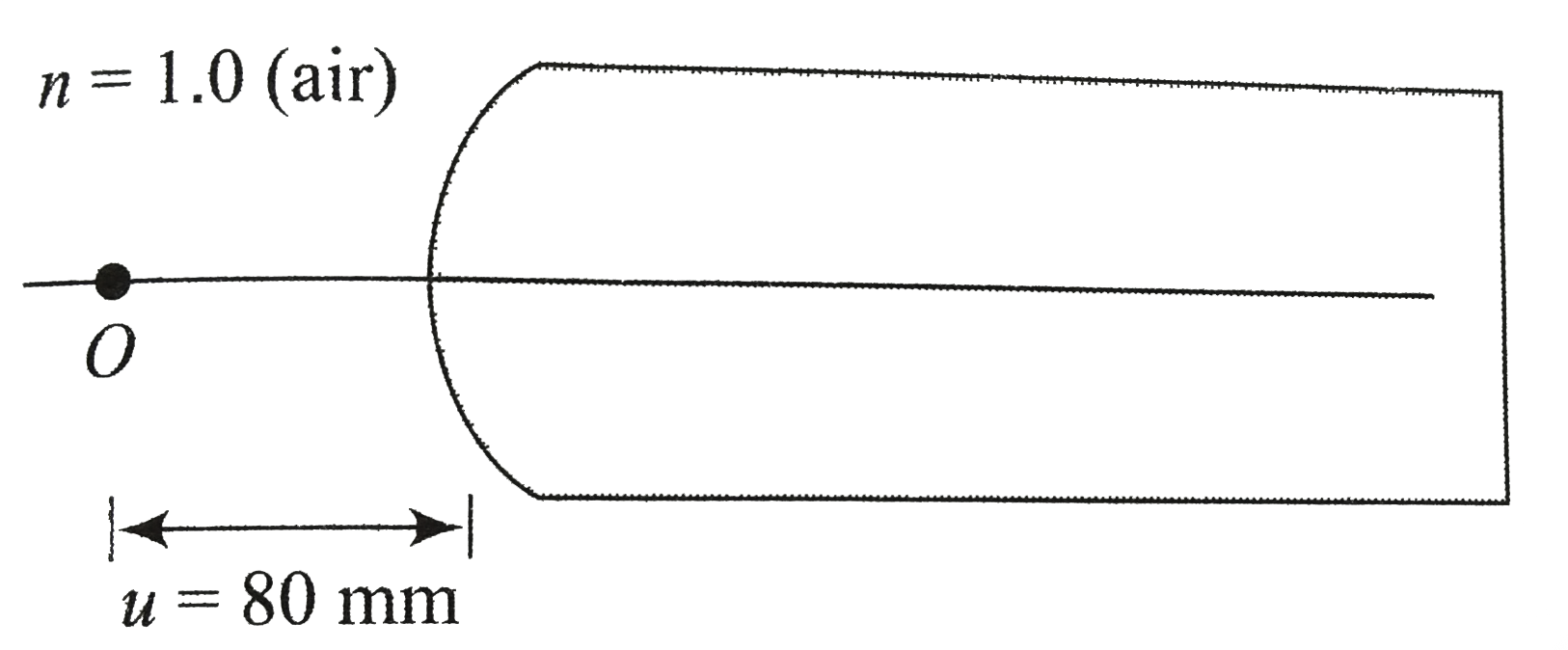One end of a cylindrical glass rod (mu = 1.5) of radius 1.0 cm is rounded in the shape of a hemisphere. The rod is immersed in water (mu= 4/3) and an object is placed in the water along the axis of the rod at a distance of 8.0 cm from the rounded edge. Locate the image of the object.
The correct Answer is:A
To solve the problem, we will use the lens maker's formula for refraction at a spherical surface. The formula we will use is:
μ2v−μ1u=μ2−μ1R
Where:
- μ1 = refractive index of the medium where the object is located (water)
- μ2 = refractive index of the medium where the image is formed (glass)
- u = object distance (negative in this case since it is measured against the direction of incident light)
- v = image distance (to be determined)
- R = radius of curvature of the spherical surface (positive since it is convex)
Step 1: Identify the given values
- μ1=43 (refractive index of water)
- μ2=1.5 (refractive index of glass)
- R=1.0cm (radius of the hemisphere)
- u=−8.0cm (object distance)
Step 2: Substitute the values into the formula
Using the formula, we substitute the known values:
1.5v−4/3−8=1.5−431
Step 3: Simplify the right-hand side
First, calculate 1.5−43:
1.5=32=96,and43=86
1.5−43=96−86=16
Thus, the right-hand side becomes:
16
Step 4: Rewrite the equation
Now we rewrite the equation:
1.5v+4/38=16
Calculating 4/38:
4/38=424=16
Step 5: Substitute back into the equation
Now the equation becomes:
1.5v+16=16
Step 6: Isolate 1.5v
Subtract 16 from both sides:
1.5v=0
Step 7: Solve for v
This implies:
v→∞
Conclusion
The image of the object will be formed at infinity.
---
- μ1 = refractive index of the medium where the object is located (water)
- μ2 = refractive index of the medium where the image is formed (glass)
- u = object distance (negative in this case since it is measured against the direction of incident light)
- v = image distance (to be determined)
- R = radius of curvature of the spherical surface (positive since it is convex)
- μ1=43 (refractive index of water)
- μ2=1.5 (refractive index of glass)
- R=1.0cm (radius of the hemisphere)
- u=−8.0cm (object distance)
Using the formula, we substitute the known values:
First, calculate 1.5−43:
1.5−43=96−86=16
Now we rewrite the equation:
Now the equation becomes:
Subtract 16 from both sides:
This implies:
The image of the object will be formed at infinity.
Topper's Solved these Questions
- GEOMETRICAL OPTICSBOOK - HC VERMA ENGLISHCHAPTER - GEOMETRICAL OPTICSEXERCISE - EXAMPLE
9 Videos
- GEOMETRICAL OPTICSBOOK - HC VERMA ENGLISHCHAPTER - GEOMETRICAL OPTICSEXERCISE - Question For short Answer
18 Videos
- GEOMETRICAL OPTICSBOOK - HC VERMA ENGLISHCHAPTER - GEOMETRICAL OPTICSEXERCISE - Objective -2
7 Videos
- GAUSS LAWBOOK - HC VERMA ENGLISHCHAPTER - GAUSS LAWEXERCISE - Short Question
7 Videos
- LIGHT WAVESBOOK - HC VERMA ENGLISHCHAPTER - LIGHT WAVESEXERCISE - Question for short Answer
11 Videos
Similar Questions
One end of a horizontal cylindrical glass rod (μ=1.5) of radius 5.0 cm is rounded in the shape of a hemisphere. An object 0.5 mm high is placed perpendicular to the axis of the rod at a difference of 20.0 cm from the rounded edge. Locate the image of the object and find its height.
View SolutionAn object is placed on the principal axis of concave mirror of focal length 10 cm at a distance of 8.0 cm from the pole. Find the position and the nature of the image.
View SolutionA hemispherical portion of the surface of a solid glass sphere (mu = 1.5) of radius r is silvered to make the inner side reflecting. An object is placed on the axis of the hemisphere at a distance 3r from the centre of the sphere. The light from the object is refracted at the unsilvered part, then reflected from the silvered part and again refracted at the unsilvered part. Locate the final image formed.
View SolutionOne end of a long glass rod (μ=1.5) is formed into a convex surface of radius 6.0cm. An object is positioned in air along the axis of the rod. Find the image positions corresponding to object distances of (a) 20.0cm, (b) 10.0cm, (c) 3.0cm from the end of the rod.
View SolutionOne end of a cylindrical glass rod shown in figure, is ground to a hemispherical surface of radius R=20mm.

a. Find the image distance of a point object on the axis of the rod, 80mm to the left of the vertex. The rod is in air.
b. Let the same rod be immersed in water of refractive index 4/3 , the other quantities having the same values as before. Find the image distance.
View SolutionAn image is formed at a distance of 100 cm from the glass surface with refractive index 1.5, when a point object is placed in the air at a distance of 100 cm from the glass surface. The radius of curvature is of the surface is
View SolutionA point object is placed at the center of a glass sphere of radius 6cm and refractive index 1.5. The distance of virtual image from the surface is
View SolutionA thin lens made of glass of refractive index μ=1.5 has a focal length equal to 12 cm in air. It is now immersed in water (μ=43). Its new focal length is
View SolutionA convex lens has a focal length of 10 cm. Find the location and nature of the image if a point object is placed on the principal axis at a distance of (a) 9.8 cm, (b) 10.2 cm from the lens.
View SolutionAn object 2.5 cm high is placed at a distance of 10 cm from a concave mirror of radius of curvature 30 cm The size of the image is
View Solution
